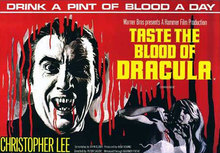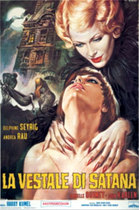Our editor-in-chief Nate Yapp is proud to have contributed to the new book Hidden Horror: A Celebration of 101 Underrated and Overlooked Fright Flicks, edited by Aaron Christensen. Another contributors include Anthony Timpone, B.J. Colangelo, Dave Alexander, Classic-Horror.com's own Robert C. Ring and John W. Bowen. Pick up a copy today from Amazon.com!
Taste the Blood of Dracula (1970)
Taste the Blood of Dracula, the fifth installment of Hammer’s Dracula series, is a well made but unfortunately routine affair. We have all the trappings of a good Hammer film: a red-eyed Christopher Lee, beautiful young women falling under his spell, a great deal of blood, and an intrepid seeker of good to put a stop to the vampire. However, in trying to expand the story of Dracula, director Peter Sasdy and screenwriter Anthony Hinds make the Count almost a guest star in his own film. While Taste the Blood of Dracula does have certain positive attributes, ultimately it is a dreary chapter in Hammer’s Dracula saga.
Victorian gentlemen William Hargood, Samuel Paxton, and Jeremy Secker (Geoffrey Keen, Peter Sallis, and John Carson) are typically repressed men, except that they are secretly libertines who clandestinely visit brothels to try to relieve their boredom. One night they encounter Lord Courtley (Ralph Bates), who entices them to sell their souls to the devil in exchange for eternal pleasure. In the midst of the Satanic ritual, which involves the blood of Dracula, the three men kill Lord Courtley in a panic. Dracula (Christopher Lee) returns to life using Courtley’s remains and decides to take revenge upon each of the men, using their own children to help him. He takes control of Hargood’s daughter Alice (Linda Hayden), and it is up to her fiancé Paul Paxton (Anthony Higgins) to save her before Dracula can turn her into his disciple.
Taste the Blood of Dracula does have much to recommend it. Its superior production design pulls us quickly into its world of decadence and revenge. The decrepit church is covered in cobwebs and dust, and it seems as if no one had ever been there in years. Meanwhile, the homes of the gentlemen are sumptuous and beautiful. This is particularly true of Secker’s study, which is filled with strange and mystical objects that subtly suggest his unusual and arcane interests. The overall effect is to convince us in little time that we are in Victorian England, awaiting the eruption of Dracula.
Peter Sasdy's stylish direction persuasively draws us into the film’s world of menace and grief. By using a hand held camera held very close to the actors, he instills a frantic sense of isolation and panic. Then, positioning the camera at a very high angle in the church, Sasdy effectively suggests the powerlessness of the characters in comparison to Dracula; conversely, he allows us to feel Dracula's power by shooting Lee from a low angle. Sasdy also makes Dracula’s resurrection scene a very memorable one; Lord Courtley’s body dissolves and a red-eyed Dracula emerges from the remains. The color red permeates the film, underscoring the importance of blood to Dracula’s life and resurrection.
The performances in the film are all superior. Surprisingly, the best performance comes not from Christopher Lee, but from Geoffrey Keen as William Hargood. He perfectly inhabits his character, underplaying Hargood as a repressed gentleman who thinks that he has seen it all, but who soon realizes that he is in over his head. His tone of voice is almost always one of disgust, and he makes it clear that Hargood believes that he is in complete command of his world. Without Keen’s outstanding performance of a truly despicable man, one of the film’s key themes, that of the sins of the father being visited upon the children, would be much less compelling.
Christopher Lee does what he can with Dracula, but his character is so limited in this film (which will be discussed below) that he is reduced to uttering lines like “The first,” and “Now,” with no other dialogue at all. Lee certainly gives his best effort; he uses his commanding presence and intense eyes to easily convinces us that he can manipulate the minds of the women that he controls and vampirizes. However, he is in the film so little that his role is little more than a cameo. While his performance is good, Lee cannot overcome the fact that his character is more of a plot device than the legendary master of evil that is Dracula.
Taste the Blood of Dracula is well designed, directed with care, and boasts a good cast. All of these good ingredients, however, cannot overcome the film’s uneven and unfocused script. It aspires to be an exploration of the sins of the father being visited upon the children. At the same time, it is also attempting to interrogate the hypocrisy of the Victorian gentlemen who present a prim and proper image to the world but live a life of debauchery in secret. These themes however have little to do with Dracula or vampirism; the effect is that Dracula is forced to seek revenge upon these men who haven’t really done anything to him. As has been noted by others1, revenge is a weak motive for the bloodsucking Count. We never see him trying to feed upon the innocent or turn people into vampires except in the way that it helps his revenge. The script could have easily been rewritten with Dracula as an evil hypnotist without too many changes to the script.
Additionally, the film very routine, going through all the motions of a Hammer Dracula film with little to invigorate it or make it unique. This is particularly obvious near the conclusion, when Paul is advised to arm himself with knowledge to defeat Dracula. He quickly finds one book that apparently contains all the knowledge to defeat a vampire. The next time we see Paul, he is now a fearless vampire killer, having learned in a matter of hours the kind of skills that took Van Helsing a lifetime to master. Taste the Blood of Dracula is the fifth film in Hammer's Dracula series, and so we must assume some knowledge of Dracula and vampires, but the ending just seems hurried, as if the filmmakers had grown weary of the story, and tacked a standard Hammer Dracula ending onto it.
Taste the Blood of Dracula is an entertaining but ultimately unsatisfying Hammer Dracula film. It has a good cast and superior direction, but its themes are disorganized and unfocused, and its title character is almost a walk-on role. It doesn’t embarrass the Hammer canon the way some of the later installments would, but it does little to add to it as well. It the end, it provokes a yawn or a shrug, not a chill or contemplation.









"Dragula" is my alternative